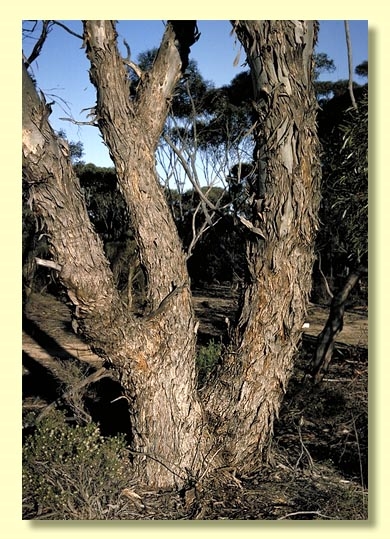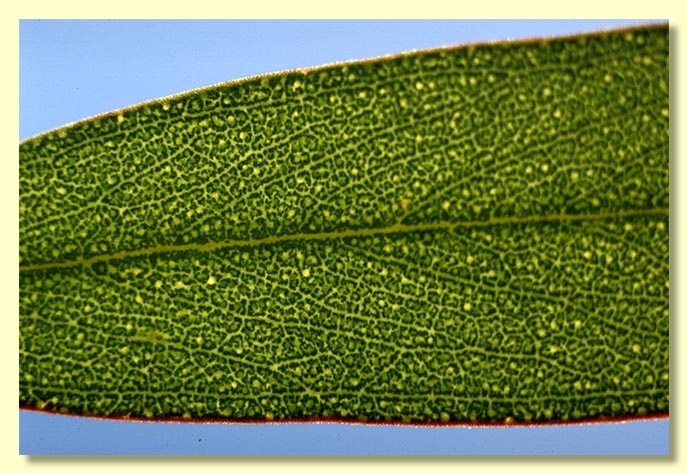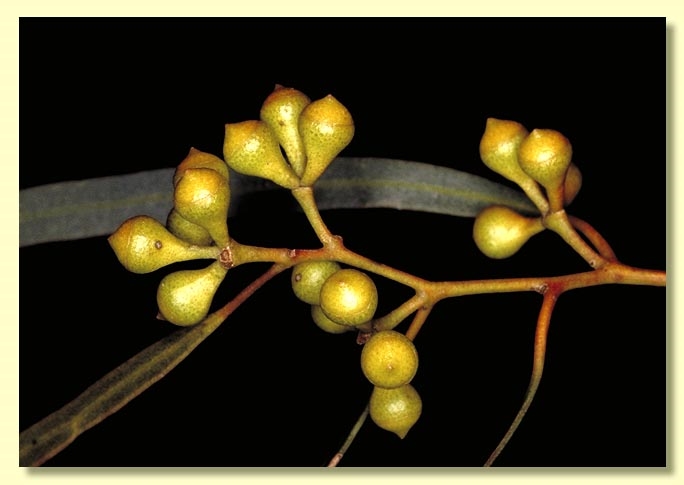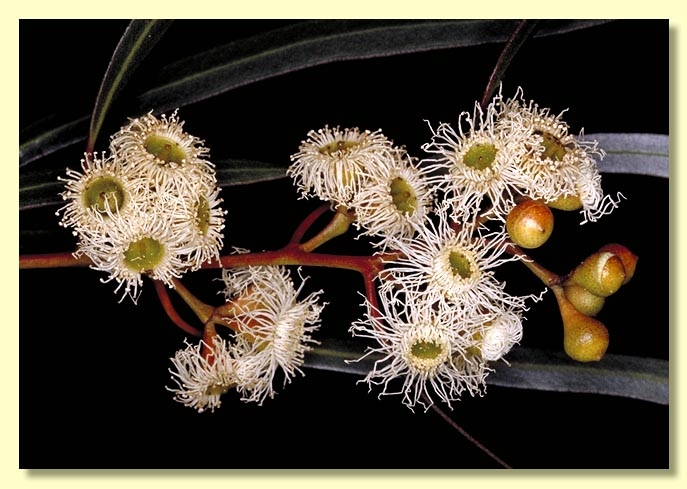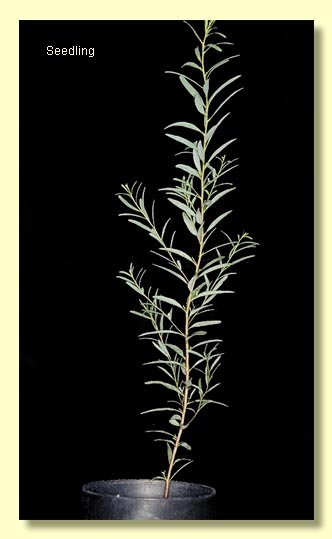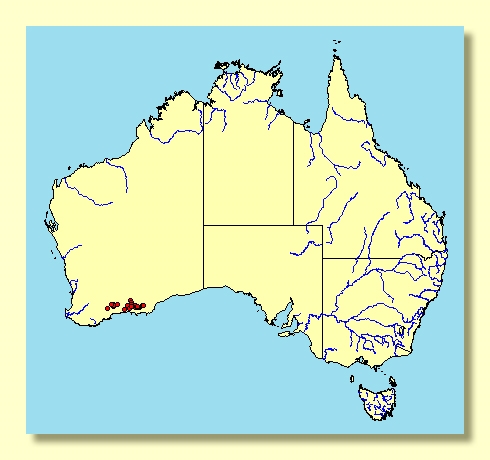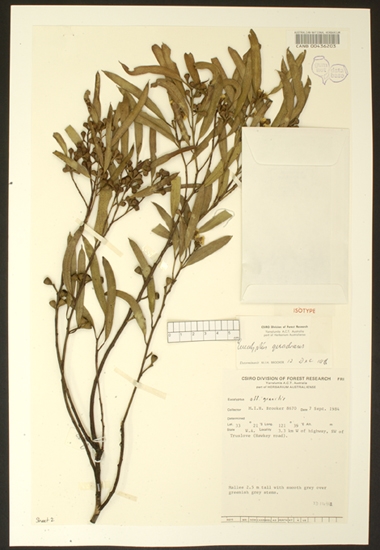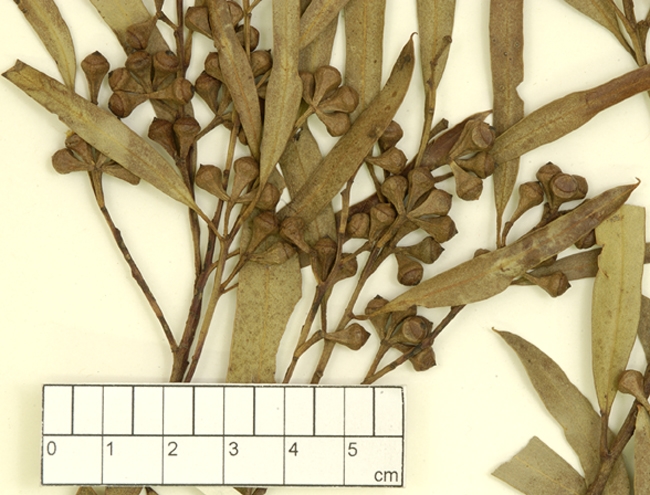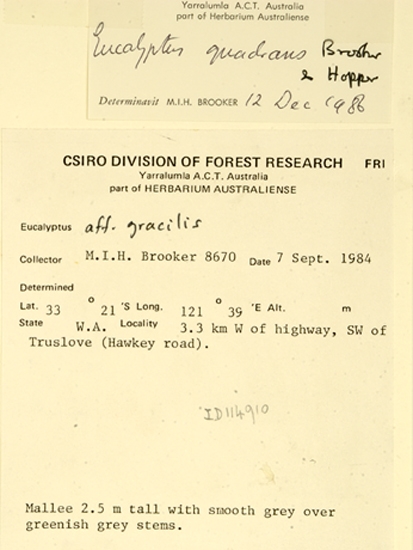Eucalyptus | Symphyomyrtus | Bisectae | Destitutae | Heterostemones
Euclid - Online edition
Eucalyptus quadrans
Bark of mallees smooth throughout, grey to pale grey over green-pink; trees have a stocking of scaly or flaky rough grey bark for up to 3 m of trunk.
Branchlets lacking oil glands in the pith.
Juvenile growth (coppice or field seedlings to 50 cm): stems rounded in cross-section; juvenile leaves always petiolate, alternate, linear, 3–7 cm long, 0.2–0.6 cm wide, grey-green.
Adult leaves alternate, petioles 0.5–1.6 cm long; blade narrowly lanceolate, 5.5–10.5 cm long, 0.5–1.5 cm wide, base tapering to petiole, margin entire, apex pointed, concolorous, glossy, dark green, side veins acute, reticulation usually moderate to dense, intramarginal vein remote from margin, oil glands intersectional, highly irregular in outline.
Inflorescence axillary, unbranched, peduncles 0.4–1.3 cm long, buds 7, pedicellate, pedicels 0.2–0.5 cm long. Mature buds obovoid to pyriform in shape with the hypanthium 4-angled i.e. square in cross-section (0.5–0.7 cm long, 0.3–0.6 cm wide), green to yellow, scar present (outer operculum shed early), operculum hemispherical and usually apiculate (0.15–0.2 cm long), stamens inflexed, the outer stamens longer and without anthers (staminodes), inner stamens short, fertile, anthers oblong-reniform (broader than long) to almost spherical, weakly versatile, sub-basifixed, dehiscing by sub-terminal short slits, style long, tapering near the base, stigma more or less rounded, locules usually (3)4(5), the placentae each with 4 vertical ovule rows. Flowers white.
Fruit pedicellate, pedicels 0.2–0.3 cm long, cupular-obconical in outline and square in cross-section (4-angled) in the basal half, 0.6–0.9 cm long, 0.4–0.7 cm wide, disc descending, valves usually (3)4(5), enclosed.
Seeds tan, 0.8–2 mm long, flattened-ovoid, dorsal surface smooth, hilum ventral.
Cultivated seedlings (measured at node 10): cotyledons Y-shaped (bisected); stems rounded to square in cross-section; leaves always subsessile to shortly petiolate, opposite for 5 to 8 nodes then alternate, linear to very narrowly elliptic-oblong, 1.7–3.5 cm long, 0.2–0.5 cm wide, dull, grey-green.
Flowering has been recorded in May, August, September and November.
A mallee or small tree endemic to Western Australia, in subcoastal areas from near Mt Ney north-east of Esperance westwards to near Lake Magenta south of Newdegate. The stems are smooth or, on larger plants, have a basal stocking of rough flaky bark. Adult leaves glossy green, and buds and fruit 4-angled.
In the classification of Brooker (2000) Eucalyptus quadrans belongs in Eucalyptus subgenus Symphyomyrtus section Bisectae subsection Destitutae because buds have two opercula, cotyledons are Y-shaped and branchlets lack oil glands in the pith. Within this subsection E. quadrans is one of seven closely related species that form series Heterostemones. This series is characterised by the barren outer stamens that are conspicuously twisted and spreading in flower and the much shorter fertile inner stamens that are held more erect. Species in series Heterostemones also have narrow fruit with a descending disc and enclosed valves while the leaves have side-veins quite acute at the base of the lamina and usually sparse reticulation.
Eucalyptus quadrans is distinguished from other species in this series by the fruit that are cupular-obconical in outline and square in cross-section in the basal half, and the very narrow seedling and juvenile leaves. Related species E. calycogona and E. prolixa also have fruit square in cross-section but are never obconical, usually more elongated and barrel-shaped to urceolate in outline with juvenile and seedling leaves broader, usually elliptical to oblong. Other species in series Heterostemones, E. brevipes, E. gracilis, E. yilgarnensis and E. celastroides, have fruit rounded in cross-section or if angular, as in the case of E. celastroides, only at base of the hypanthium and rounded above.The opercula of E. quadrans are often apiculate.
Plants in the west of the species geographic range have smaller buds and fruits than those north of Esperance.


